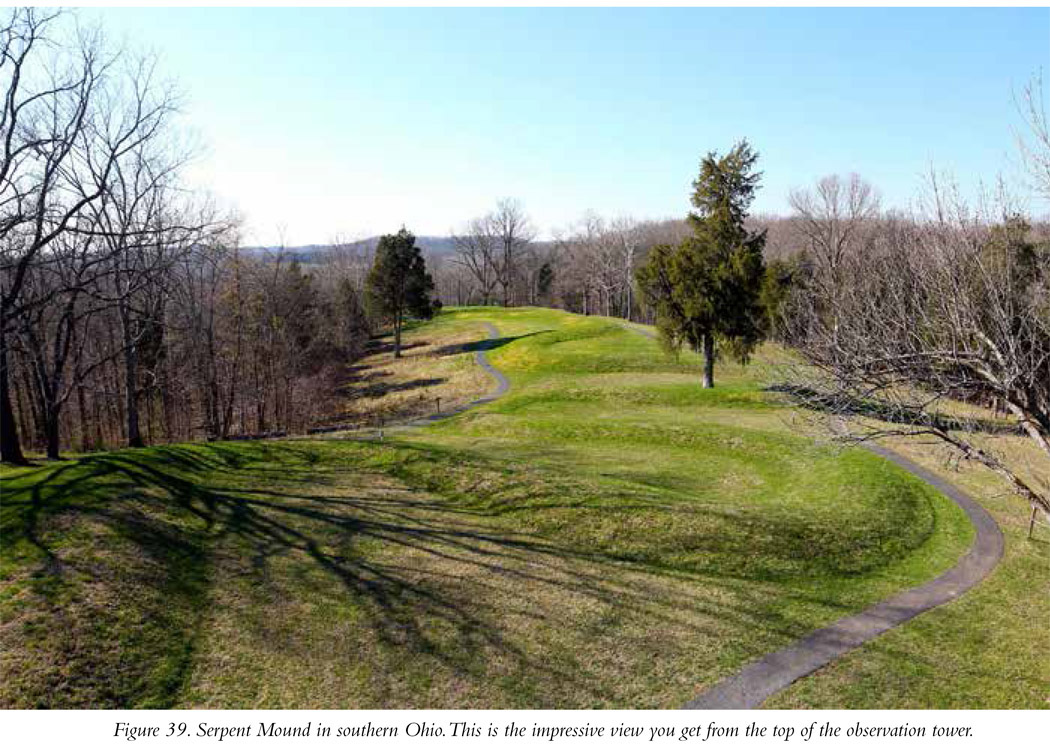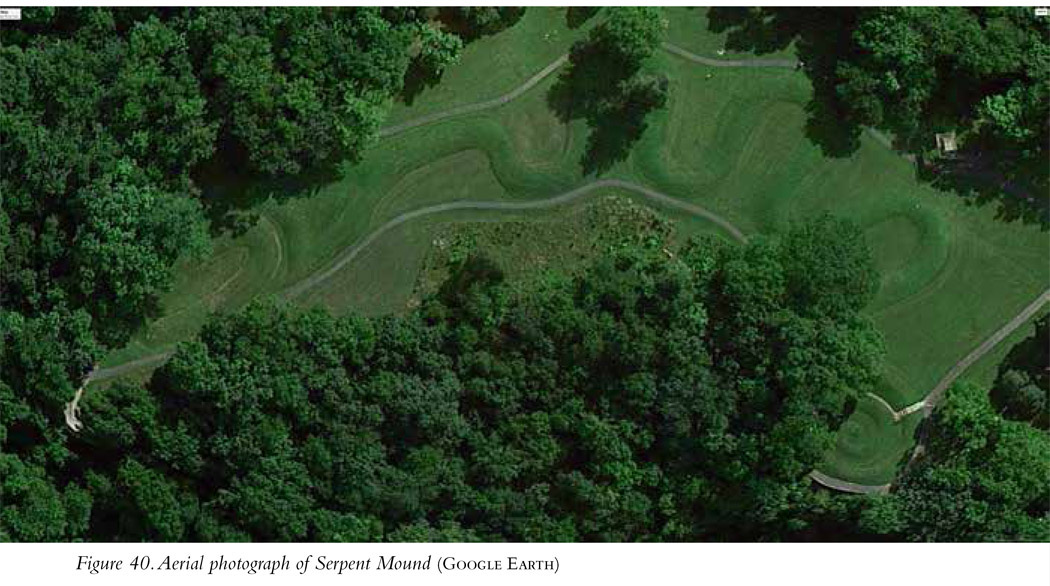
Peebles, Ohio
Journal Entry
April 20, 2014
As an archaeologist with a PhD, I am probably not supposed to say this, but you need to go to Serpent Mound for no other reason than it is just so incredibly cool. The earthwork is an effigy mound of sculpted earth more than 1,350 feet long in the sinuous, meandering shape of a coiled serpent resting on a peninsular, steep-sided ridge (Figure 39). The tail end spirals in on itself and resembles that of a rattlesnake. At its other end, the mouth is gaping and open, about to eat what appears to be an earth mound in the shape of an egg. We climbed to the top of the viewing tower for a bird’s-eye view of the monumental snake. Just incredible. The tower is open, without walls, so if you have a fear of heights you might be a bit uncomfortable. But work through it; it’s not that bad and well worth the trip up for the perspective it affords. During my most recent visit, an adorable and brave little girl of about eight or nine climbed to the top by herself while her scaredy-cat father (a very tough looking dude with lots of tattoos) stayed on the ground. Don’t be that dad!


Serpent Mound is an impressive work of sculptural art likely imbued with sacred power by the people who built it. It is an amazing thing to see and ponder (Figure 40).
What You Will See
Serpent Mound likely dates to the period after AD 1000; recent radiocarbon dating of organic material found inside the mound produced a date of AD 1040. This is long after the Hopewell Culture, whose people had built the burial mounds at, for example, Site 18, Mound City, were gone. Serpent Mound dates to a later people, the bearers of the Fort Ancient Culture.
A paved pathway takes you along both sides of the serpent. Definitely walk the path for the view it provides of the snake’s head and coiled tail. There are lots of sign-posted alignment markers at the site. It appears that the positioning of the coils of the great serpent wasn’t random; the loops were aligned to important points on the horizon, which marked the moon’s monthly dance across the sky. This was a way for the makers of Serpent Mound to keep track of important days during the year. In other words, Serpent Mound was a sort of lunar calendar.
On a visit to the site back in 2009, I met with the site caretaker, Keith Bengston. Keith mentioned that New Agers had recently been drawn to the site, especially at the solstices, the first day of summer (and the day of the year with the most daylight hours) and the first day of winter (the day with the fewest daylight hours). Further, some New Agers apparently have decided that the mound’s shape is not that of a snake but a sperm. This has led to some people sneaking into the state park after hours and having sex on top of the mound. Freud would have had a field day with people who have sex on top of a sculpture of a giant snake. Poor Keith was tasked with the job of cleaning up. Uh, gross.
I don’t know about New Age perspectives about Serpent Mound, but it certainly is a special place that resonates with the intelligence and spirituality of its builders. When I was last there, it was a breezy day, with the wind producing very eerie sounds as it blasted through the trees growing along the edge of the ridgetop on which the effigy was built. It seemed a very appropriate “special effect.”
There is a small museum at the site, but the displays have not been updated for quite some time, and budget cuts have curtailed the hours during which it is open. Don’t worry too much about it; the mound is what you go there to see.
Why Is Serpent Mound Important?
Serpent Mound is one of a large number of earthworks in America known as “effigy mounds.” As described earlier, these were monumentally scaled sculptures of earth in the shape of various animals including snakes, turtles, birds, and bears, among others. Serpent Mound is the best known because of its enormous size, location on a topographic eminence, state of preservation, and incredible and mysterious beauty. Recent analysis of the alignment of the serpent indicates that, along with the coils aligning with the moon, the head points toward the setting sun at the summer solstice, much in the way that Stonehenge, in the south of England, lines up with the day that marks the beginning of summer in the Northern Hemisphere.
Serpent Mound provides an important look inside the minds of ancient people who recognized the beauty and mysterious power of the snake and memorialized it on a grand scale.
Site Type: Effigy Mound
Wow Factor: **** It’s a giant snake sculpted in earth. That’s very cool.
Museum: There is a very small on-site museum. I’ve been to Serpent Mound a few times, and the museum has never been open.
Ease of Road Access: *****
Ease of Hike: ***** The hike around the snake is very easy; it’s a pretty flat, paved pathway. Climbing to the top of the observation tower might be a challenge to anyone with bad knees but is otherwise no great challenge.
Natural Beauty of Surroundings: ***
Kid Friendly: ** It’s a giant snake. Kids will think that’s pretty cool.
Food: Bring your own.
How to Get There: Serpent Mound is located just off OH 73, 6 miles north of OH 32 and 20 miles south of Bainbridge in Adams County.
Hours of Operation: Open daily 9 a.m. to dusk
Cost: Free if you’re a member of the Ohio Historical Society or the Arc of Appalachia Preserve System. See website for nonmember rates.
Best Season to Visit: Any time
Website: www.ohiohistory.org/museums-and-historic-sites/museum--historic-sites-by-name/serpent-mound
Designation: State park; National Historic Landmark